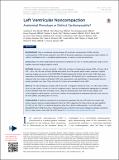Left ventricular noncompaction : anatomical phenotype or distinct cardiomyopathy?
Abstract
Background: There is considerable overlap between left ventricular noncompaction (LVNC) and other cardiomyopathies. LVNC has been reported in up to 40% of the general population, raising questions about whether it is a distinct pathological entity, a remodeling epiphenomenon, or merely an anatomical phenotype. Objectives: The authors determined the prevalence and predictors of LVNC in a healthy population using 4 cardiac magnetic resonance imaging diagnostic criteria. Methods: Volunteers >40 years of age (N = 1,651) with no history of cardiovascular disease (CVD), a 10-year risk of CVD < 20%, and a B-type natriuretic peptide level greater than their gender-specific median underwent magnetic resonance imaging scan as part of the TASCFORCE (Tayside Screening for Cardiac Events) study. LVNC ratios were measured on the horizontal and vertical long axis cine sequences. All individuals with a noncompaction ratio of ≥2 underwent short axis systolic and diastolic LVNC ratio measurements, and quantification of noncompacted and compacted myocardial mass ratios. Those who met all 4 criteria were considered to have LVNC. Results: Of 1,480 participants analyzed, 219 (14.8%) met ≥1 diagnostic criterion for LVNC, 117 (7.9%) met 2 criteria, 63 (4.3%) met 3 criteria, and 19 (1.3%) met all 4 diagnostic criteria. There was no difference in demographic or allometric measures between those with and without LVNC. Long axis noncompaction ratios were the least specific, with current diagnostic criteria positive in 219 (14.8%), whereas the noncompacted to compacted myocardial mass ratio was the most specific, only being met in 61 (4.4%). Conclusions: A significant proportion of an asymptomatic population free from CVD satisfy all currently used cardiac magnetic resonance imaging diagnostic criteria for LVNC, suggesting that those criteria have poor specificity for LVNC, or that LVNC is an anatomical phenotype rather than a distinct cardiomyopathy.
Citation
Weir-McCall , J R , Yeap , P M , Papagiorcopulo , C , Fitzgerald , K , Gandy , S J , Lambert , M , Belch , J J F , Cavin , I , Littleford , R , Macfarlane , J A , Matthew , S Z , Nicholas , R S , Struthers , A D , Sullivan , F , Waugh , S A , White , R D & Houston , J G 2016 , ' Left ventricular noncompaction : anatomical phenotype or distinct cardiomyopathy? ' , Journal of the American College of Cardiology , vol. 68 , no. 20 , pp. 2157-2165 . https://doi.org/10.1016/j.jacc.2016.08.054
Publication
Journal of the American College of Cardiology
Status
Peer reviewed
ISSN
0735-1097Type
Journal article
Description
The present study was funded by the Souter Charitable Foundation and the Chest, Heart and Stroke Scotland Charity. Dr. Weir-McCall is supported by the Wellcome Trust through the Scottish Translational Medicine and Therapeutics Initiative (Grant no. WT 085664) in the form of a Clinical Research Fellowship.Collections
Items in the St Andrews Research Repository are protected by copyright, with all rights reserved, unless otherwise indicated.

